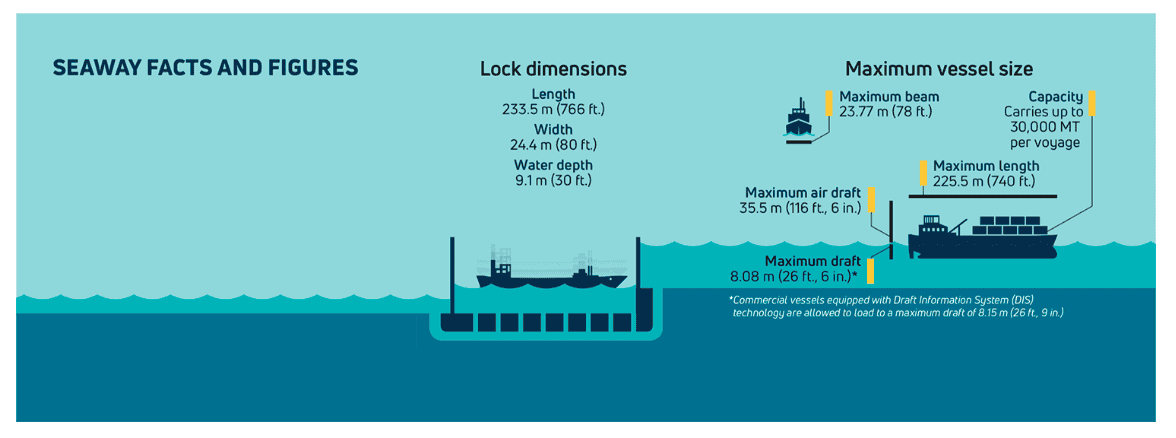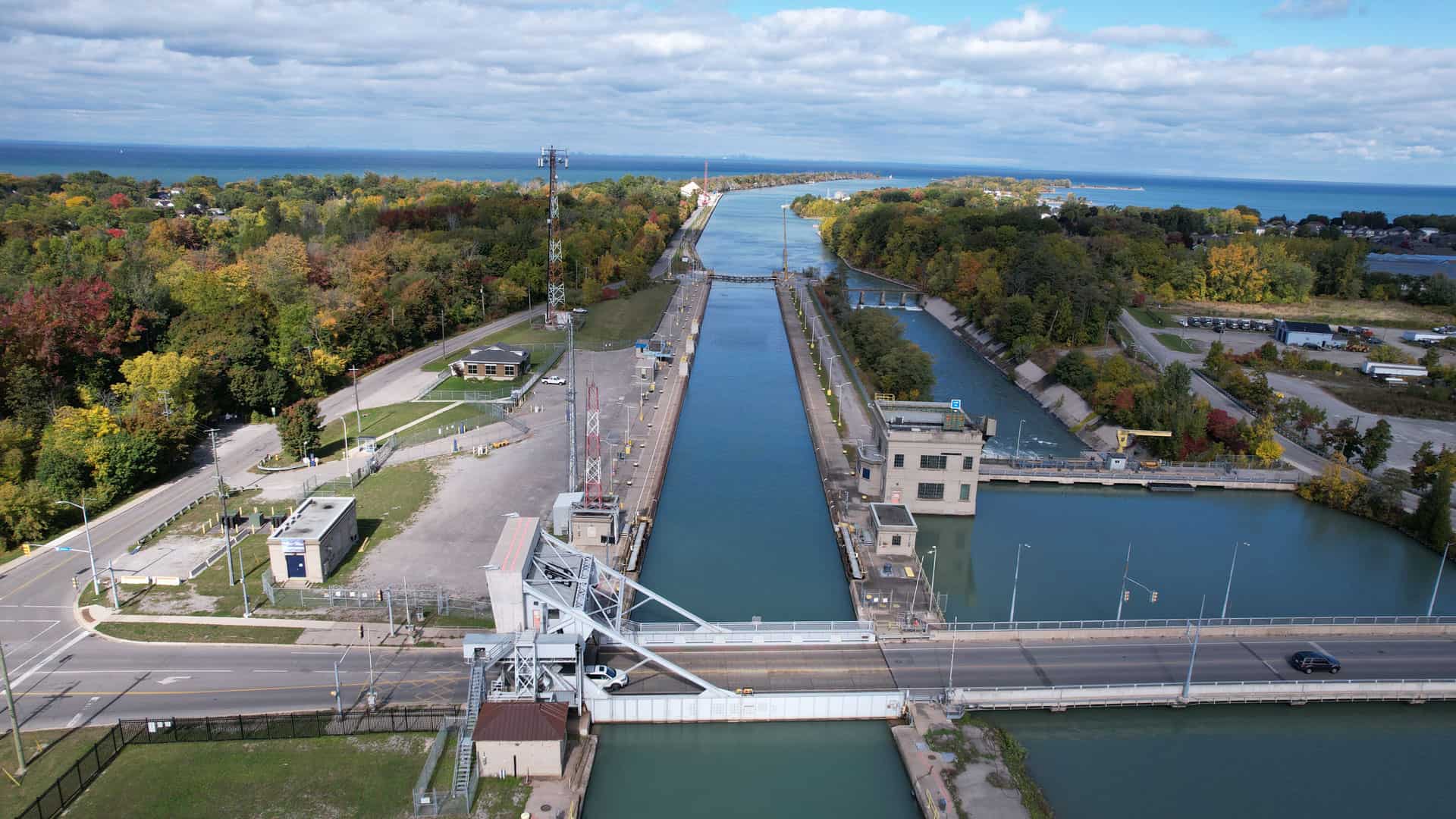HWY H2O By the Numbers
- 450 billion
the value of the more than 3 billion tonnes of cargo carried along the St. Lawrence Seaway since its opening
- $3.6 billion
saved by cargo shippers in transportation costs each year
- 329,000
the number of direct and indirect jobs related to the waterway
- 298 days
the longest navigation season on record, set in 2017
Efficient access and competitive advantage
- Direct access to the industrial hub of North America, getting you closer to your final destination; saving you time and money
- Intermodal facilities and modernized infrastructure connect the ports to major North American markets; lending ease and efficiency
Reliability and Capability
- Our System provides more than 98% availability and reliability; available capacity allows your cargo to arrive on time
- Modern facilities and innovative technologies complement our safe, efficient and reliable service record
Strategic access
- Major ports are within an 8 hour drive to a market of 150 million people
- Shipping direct via the Great Lakes eliminates traffic flow congestion
- Over 40 international and regional ports provide connection to major markets
Shipping solutions for every cargo
- Ship a variety of cargo including: grain, iron ore, steel, aggregates, liquid bulk and project cargo
- Trust in our experienced stakeholders and members
- Flexible storage and staging of cargo with ample lay down area
- Great Lakes/Seaway marine shipping saves cargo shippers $3.6 billion in transportation costs every year.
Sustainable Marine Transport
- Marine transportation offers the best fuel economy
- System wide infrastructure investments, including Hands-Free Mooring
- Resource Savings: A single Seaway-sized laker can carry about 30,000 tonnes of cargo. An equivalent amount of cargo on land would require a fleet of 963 large trucks or 301 rail cars

Lock dimensions in the Seaway can allow for a maximum vessel length of 740 feet (227.7 meters), maximum beam of 78 feet (24 meters) and maximum draft of 26′ 6″ (8.09 meters). The Seaway uses the Automatic Identification System (AIS) for vessel movements which enhances safety, help reduce transit times and aids in fleet management for ship owners. To transit the Seaway and navigate the locks in the System, some fittings are required, more can be found in the Seaway Handbook at https://greatlakes-seaway.com/en/commercial-shipping/seaway-handbook/
FAQs
- Who is behind HWY H2O ?
- What are the HWY H2O objectives?
- What is short sea shipping and how does it work?
- What are the benefits of moving cargo by the marine mode along the Seaway?
- What is being done to ensure that the issue of aquatic invasive species does not escalate?
- Are there environmental benefits associated with utilizing marine transport?
HWY H2O is an alliance of transportation stakeholders, actively promoting marine transportation on the Great Lakes / Seaway System. The St. Lawrence Seaway Management Corporation and the Great Lakes St. Lawrence Seaway Development Corporation are sponsors of the program. Port Partners and Members include commercial entities such as ports and transportation associated enterprises, like stevedores, carriers and municipalities.
Initiated in 2003, HWY H2O works to identify and promote key opportunities for the marine mode on the Great Lakes St. Lawrence Seaway System. The St. Lawrence Seaway offers unparalleled capacity to increase cargo volumes within its existing infrastructure. HWY H2O is committed to raising awareness of the Seaway’s untapped potential for meeting current and future transportation challenges in an economically sound and environmentally responsible manner.
Short sea shipping refers to the movement of cargo by water between points situated within relatively close proximity to one another. This may include domestic as well as international maritime transport along coastlines or within lakes and inland water systems.
The application of short sea shipping along HWY H2O is based on the reality that most container vessels are too large to fit into the Seaway. Container vessels currently under construction are even larger yet, bringing about a future where only a limited number of coastal hub ports will be able to accommodate these enormous ships.
Accordingly, part of our vision for short sea shipping along HWY H2O sees large ocean-going container vessels docking at coastal hob ports, such as Halifax, Nova Scotia where they would transfer their cargo to smaller “feeder” vessels, which would deliver the containers to a Seaway / Great Lakes port near their final destination.
It is important to note, “feedering” presents the added environmental benefit of further mitigating the risk of introducing exotic or invasive species to the Great Lakes St. Lawrence Seaway System. Since feeder vessels would only transit routes within the waters of our own continental boundaries, they will not be carrying ballast water from overseas destinations. This approach can mitigate the potential introduction of aquatic invasive species to the Great Lakes / Seaway System via ballast water.
Other important benefits associated with short sea shipping along HWY H2O include the alleviation of congested road and rail arteries and the reduction of greenhouse gas emissions.
Highway H2O allows cargo to bypass border bottlenecks on railways and roads. The waterway’s available capacity and unrestricted movement of cargo, in combination with the marine models unmatched safety and fuel efficiency make moving cargo along HWY H2O attractive to shippers, their customers and the businesses and communities who depend on the reliable delivery of their cargo.
HWY H2O partners are committed to ensuring the waterway is maintained and developed in a manner that is environmentally and ecologically responsible.
For an update on the latest initiatives, please consult the St. Lawrence Seaway’s ballast water page at:
https://www.greatlakes-seaway.com/en/environment/ballast-water/
Transporting goods by water delivers substantial environmental benefits, including:
- Energy efficiency – On a single litre (about a 1/4 U.S. gallon) of fuel, one tonne of freight can travel 240 km by ship, compared with less than 100 km by train and less than 30 km by truck
- Reduced emissions – Ships only emit one tenth the greenhouse gas emissions that trucks produce and half that of trains
- Increased safety – The marine mode is the safest mode of domestic and international freight transportation, thus reducing the likelihood of environmental harm caused by accidents and spills
- Minimal noise – Marine transportation generates very little noise, when compared to other forms of transport
- Mitigated need for future highway and rail line infrastructure investment – Utilizing HWY H2O decreases the need for new roadways and rail lines, the creation of which negatively impact quality of life, communities and the ecosystem
Every mode of transportation creates an environmental footprint, and it’s important to note that the elimination of one maximum size Seaway vessel would require the addition of 963 truckloads on our highways, or the addition of 301 railcars to the rail system. Any addition of trucks or rail cars to our roads and railways would only serve to exacerbate current issues of congestion faced by those modes of transport and associated environmental effects.
Ship With Us
Simple. Competitive. Connected
Connect with our Business Development Specialist.
Get Connected